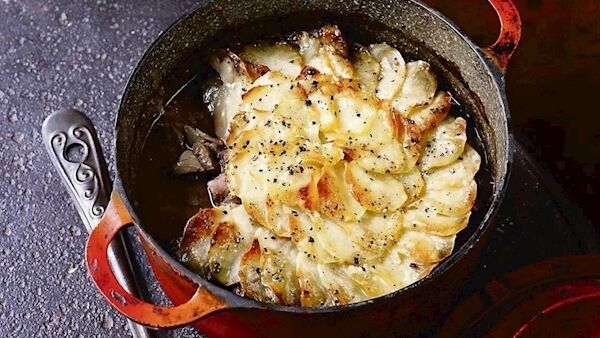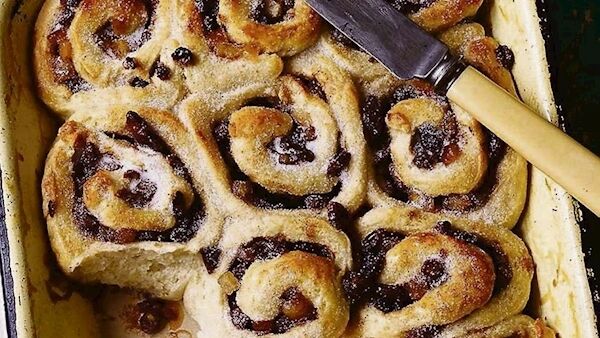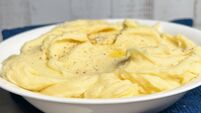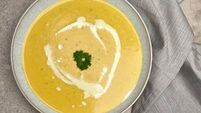Recipes for when the only requirement is comfort

Darina believes that food is an essential part of the fabric of a family; it should be nourishing, and it should always be nurturing.
"Nowadays more than ever before we need comfort food! So I’m going to devote my first column of the year to simple homely dishes guaranteed to warm and cheer the family when they traipse in tired and hungry from school or after a long day’s work.
"The sort of food that everyone will want to tuck into around the kitchen table.
Perhaps this is the time for a New Year’s resolution to ban the ‘damn telly’ out of the kitchen or at least have an unbreakable rule that it doesn’t get switched on during meals.
"Even if people are arguing it keeps the lines of communication open! Better still, cook together. Peeling and chopping really can be fun when everyone is chatting, squabbling and having a laugh.
"It helps to share the workload and best of all it passes on the cooking skills in an effortless easy way.”
Alison Henderson's baked cheesecake
The top of this usually cracks as it cools, but don't worry- this doesn't affect the flavour.
To make the cream cheese, heat the milk, cream and fine lemon zest to blood temperature, then remove from the heat and stir in the rennet. Cover and leave in a warm place for 3 hours, until set.
Cut the curd into squares with a clean knife. Line a colander with a double layer of muslin or cheesecloth. Gently scoop the curds into the cloth with a large spoon, taking care to break them as little as possible. Leave to drain for at least 12 hours.
For the cheesecake, mix the powdered biscuits with the melted butter and press into the base of the cake tin. Chill for 30 minutes. Preheat the oven to 160ºC/ Gas 3.
Put the cream cheese or cottage cheese, egg yolks and 50g of the sugar into a bowl. Add the yoghurt and beat until smooth. Add the sultanas.
Next whisk the egg whites in a large, clean, dry bowl until they reach stiff peaks. Gradually add the remaining sugar, and whisk until stiff and glossy. Carefully fold the whisked egg white and sugar mixture into the cheese mixture. Pour into the biscuit base and decorate with the almonds. Bake for 45 minutes until golden, risen and set.
Meanwhile, make the apricot glaze. In a small stainless steel saucepan, melt the apricot jam with 1-2 tablespoons of lemon juice or water. Push the hot jam through a nylon sieve.
Leave to cool for 5 minutes, then run a sharp knife around the edge of the cheesecake to loosen it and minimise surface cracking. When cool, finish with the apricot glaze (melt and stir it before use if necessary). Store any leftover glaze in a sterilised air-tight jar.
SCALLOPED POTATO WITH STEAK AND KIDNEY
This is an economical and enormously comforting dish. We used to ask my mother to make it when we came home from college on winter weekends. You can do lots of variations on the theme; streaky bacon is particularly good, and shoulder of lamb would also be delicious.

Heat the oven to 150˚C/gas mark 2. Remove the skin and white core from the kidney and discard. Cut the flesh of the kidneys into 1cm cubes, put them into a bowl, cover with cold water and sprinkle with a good pinch of salt. Cut the beef into 5mm slices.
Put a layer of potato slices at the base of the casserole. Drain the kidney and mix them with the beef slices, then scatter some of the meat and chopped onions over the layer of potato.
Season well with salt and freshly ground pepper, dot with butter, add another layer of potato, more meat, onions and seasoning and continue right up to the top of the casserole.
Finish with an overlapping layer of potato. Pour in about 370ml of stock. Bring to the boil, cover and transfer to the oven, and cook for about 2 hours 15 minutes or until the meat and potatoes are cooked.
Remove the lid of the saucepan about 15 minutes from the end of the cooking time to brown the top slightly.
Sprinkle with chopped parsley and serve in deep plates with lots of butter.
BRAISED LAMB SHANKS WITH GARLIC, ROSEMARY AND CANNELLINI BEANS
This is where the magic of slow cooking transforms something that, cooked on a high heat, would be very tough, into something soft and tender.

Make the tomato fondue: heat the oil in a casserole or stainless-steel saucepan. Add the onions and garlic and toss until coated. Cover and sweat on a gentle heat until the onions and garlic are soft but not coloured.
Slice the tomatoes and add with all the juice to the onions. Season with salt, pepper and sugar. Add a generous sprinkling of herbs. Cook, uncovered, for about 10 minutes, or until the tomatoes soften. A few drops of balsamic vinegar at the end of cooking will greatly enhance the flavour.
Next, preheat the oven to 150ºC/Gas 2. Remove most of the fat from each shank and then scrape the meat away from the bone to loosen it.
Make two deep incisions in each joint and insert a sprig of rosemary and a sliver of garlic wrapped in half an anchovy fillet into each incision. Season the meat with salt and black pepper.
Heat the duck fat or olive oil in a heavy sauté pan or casserole and sauté the meat until it is well browned on all sides. Remove the lamb shanks from the pan.
Next add the bacon and cook until crisp, then add the carrots, celery, leek, onion and garlic and cook over a high heat until slightly browned.
Add the red wine to the pan and bring to the boil, stirring for a minute or two. Add the stock, herbs and orange peel to the pan, then place the lamb shanks on top. Cover and cook in the oven for 2¼ hours.
Remove from the oven and add the tomato fondue, cannellini beans, herbs and enough stock to half-cover the beans. Cover and simmer for a further 45 minutes to 1 hour.
When the lamb has finished cooking it should be falling off the bone. Remove the thyme, bay leaves and orange peel. Taste and correct the seasoning.
Serve the lamb shanks in a hot, deep dish with the beans and vegetables poured over and around. Garnish with sprigs of fresh rosemary and thyme.
CHELSEA BUNS
This is a basic recipe for rolled-up buns; once you’ve mastered this technique, you can vary the fillings according to your fancy.

Dissolve the yeast in a little of the tepid water. Sieve the flour, sugar and salt into a bowl. Rub in the butter and then add the whisked eggs. Add the yeast mixture and enough additional water to make a fairly soft dough.
Cover and leave to rest for 10 minutes. Turn out onto a floured board. Knead well, about 5-10 minutes, until the dough becomes firm and springy. It should bounce back when pressed with a finger.
Put into a deep bowl, cover with clingfilm and leave to rise until it doubles in size. Punch down to knock out the air and redistribute the yeast back in contact with the dough.
Knead well for 2-3 minutes. Leave to rest for a further 5 minutes. Roll the bun dough into a rectangle measuring about 25 x 40cm. Brush with half of the cooled, melted butter.
Combine the sultanas, candied peel, brown sugar, lemon zest and mixed spice or cinnamon in a bowl and mix. Sprinkle the buttered dough evenly with the fruit mixture. Roll lengthways into a fairly tight cylinder.
Then brush with the remaining melted butter and divide into 12-16 pieces. Place them cut-side down on a lightly greased 2.5cm deep tray, fairly close together.
Egg wash the tops and leave to rise in a warm place until doubled in size. All the buns will be touching each other. Bake at 220˚C/gas mark7 for about 15 minutes.
Remove from the oven and, while still hot, brush with bun wash and dust with sugar.







